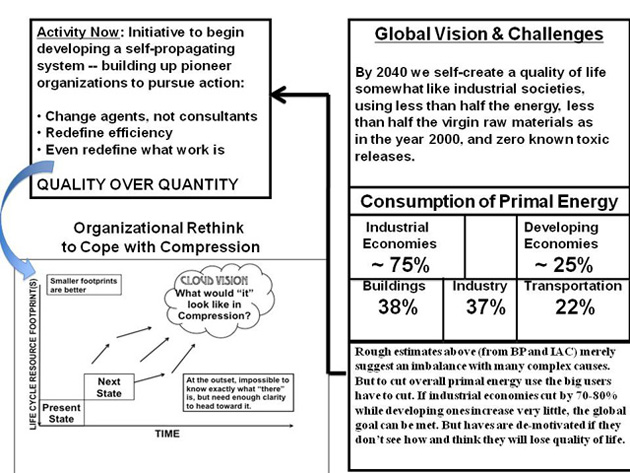November 16, 2010
Global Compression is necessary to globally reduce the consumption of resources. But from a conventional business and economic view, Compression’s operational goal is unimaginable:
By 2040 globally develop a quality of life somewhat like industrial societies today, but using less than half the virgin raw material and less than half the energy as in the year 2000, and with no known toxic releases.
However, the figure below shows the difficulty of continuing to develop industrial economies by burning a lot of primal energy for heat, cooling, transport, and processing material. (Primal energy is all energy that is traded.) That the squeeze is on is becoming more certain. For instance, the latest report of the International Energy Agency pronounces that “peak oil” has already happened (in 2006), and that at present trends we’ll have an extended period of flat output.
The developing world’s conundrum is to improve life without using much more energy and material. Motivation devising how to do this in industrial societies may be harder than in developing regions, despite their manifest problems. There, people seeking a better quality of life may devise simple, but ingenious ways to do it. But in old industrial societies, people fear losing what they have if they cannot see how to divorce quality of life from profligate resource use. That’s a more emotional mind set change, so redirecting of imagination may need to occur in stages.
Nonetheless, it seems necessary. Drastically cutting resource consumption can’t be done without addressing large quantity resource consumption, and that’s our industrialization processes as we conceived of them today, including the market expectations that drive it. At some point, we can no longer pretend that “reset” is merely a delay resuming business much as usual. Unless we suddenly harness clean energy on a big scale, anyone with industrial operating experience realizes that their life and business models are headed for a revolution.
Means, methods, and innovations have been developed. More can be developed, for example by the approaches of The Blue Economy or the Rocky Mountain Institute. And by a major extension of lean thinking, plenty of ideas are gestating to dramatically reduce the volume of truck transportation without cutting the volume of goods now consumed, and of course that too can be done. Technical pathways to Compression appear “doable.” But our big hurdle is the head turning necessary to become serious.
1) BP 2010 Statistical Review of World Energy
2) IAC = InterAcademy Council, “Lighting the Way“

